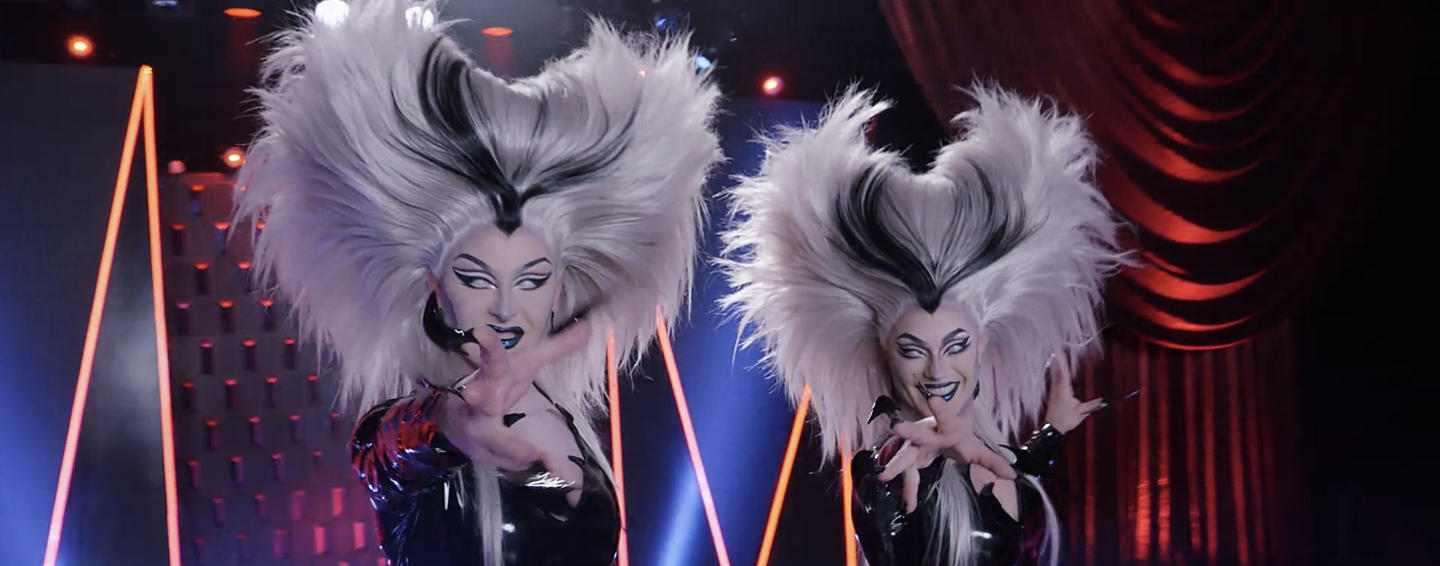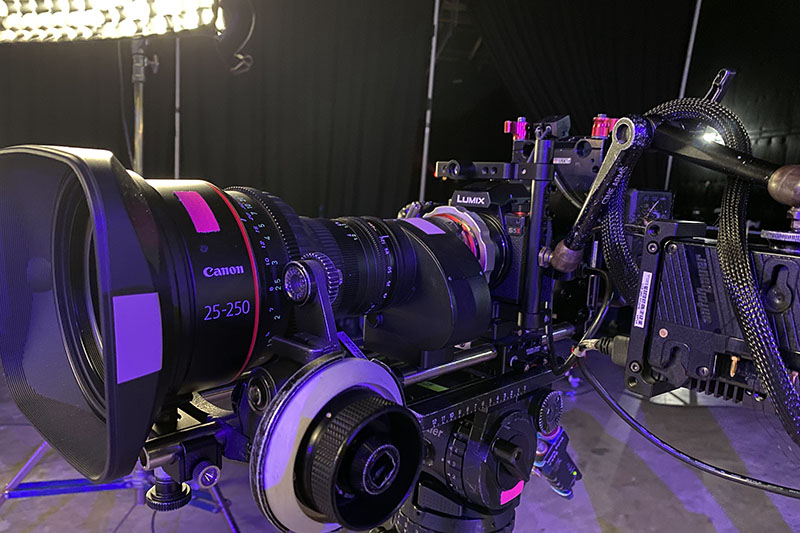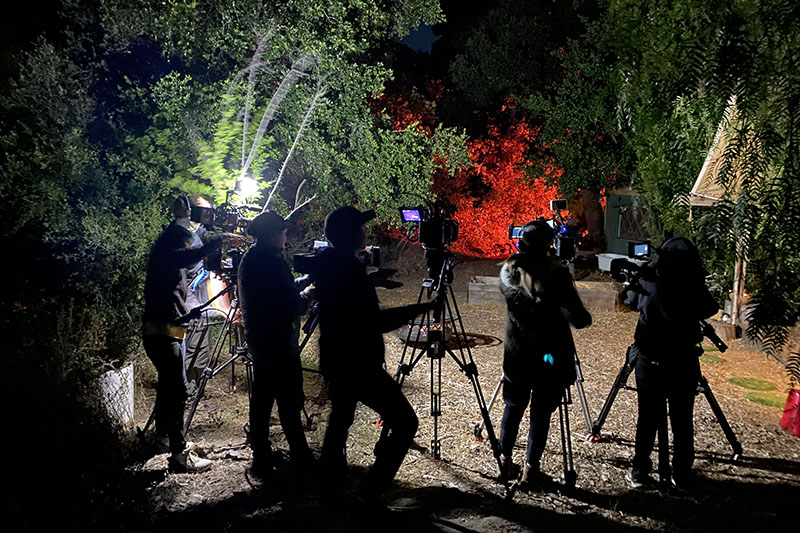Carissa Dorson Shoots The Boulet Brothers' Dragula

Spooky Glam
DP Carissa Dorson captures "The Boulet Brothers' Dragula" with LUMIX and EVA1 cameras
Cinematographer and LUMIX ambassador Carissa Dorson's introduction to the world of reality television came through her recent involvement in The Boulet Brothers' Dragula, which marked her debut as a DP in the genre. Celebrating the underground and alternative, The Boulet Brothers’ Dragula showcases artists from around the world competing in challenges that test their skills in drag, horror, and glamour. The show is both hosted and directed by the Queens of Darkness, drag queens Dracmorda and Swanthula Boulet (aka The Boulet Brothers). For season five, which was shot at Quixote North Valley Studios, Dorson used a combination of Panasonic EVA1 cinema cameras and LUMIX box and hybrid mirrorless cameras.
Dorson’s biggest challenge was the learning curve associated with a reality competition show. She was a fan of drag, and familiar with The Boulet Brothers’ Dragula, but she wanted to bring a fresh look to the series. “I felt the show would benefit from showcasing the competitors on stage in a way that wasn't heavily edited like a music video” she explained. “I wanted to use dynamic camera moves to stay with each performer for longer, as well as shoot from a multitude of interesting angles, both in slow motion and real speed.”
DP Carissa Dorson shot "The Boulet Brothers' Dragula" with a number of LUMIX and EVA1 cameras.
Leveraging her background in narrative filmmaking, Dorson introduced a more cinematic quality to the show. Starting with an opening scene that paid homage to classic Universal Monsters movies, and concluding with a "death" scene, Dorson integrated elements of the horror genre into these sequences, which were captured in anamorphic on a Lumix S1H. “Reality shows usually employ flat lighting in order to cover the subjects anywhere on set, but I was able to add a few more accents in the sets we built this season,” revealed Dorson. “There's ‘The Lab’ set, where the competitors are working on their costumes and making their monsters. My gaffer, Lawrence Le, and key grip, Tiara Olson, aimed Lekos down on each of the work tables, bringing a bit more shape to the lighting. We still used fill light to make sure you can see everything, but I was happy with the level of contrast we achieved.”
Zone Coverage
Starting with 11 competitors, Dorson approached shooting the show similar to zone coverage in sports with up to six or seven cameras rolling at a time. She had a wide camera, capturing a master, and would typically have three cameras covering three to four people each in frame. She would also use zoom lenses to snap in if anything unexpected happened, or if she needed to catch a specific reaction. She had two additional cameras that were used for roaming close-ups.
“I would be at a monitor, talking on headsets to all of my operators,” revealed Dorson. “If any two operators were getting the same shot, I would direct them away from that. I let them know what was important to cover because the story producer would be sitting next to me, telling me to get ready for certain reactions.”
Dorson (right) and her camera operators pose for a shot between setups.
The Boulet Brothers’ Dragula was shot entirely with Panasonic cameras. Dorson had three EVA1 cinema cameras, one of them with a Canon CN-E 15.5-47mm T2.8 L S Wide-Angle Cinema Zoom Lens, capturing the wide angles. Another EVA1 was used as a handheld camera capturing b-roll and backstage footage with a Fujinon ZK19-90mm T2.9 Cabrio Lens. Her third EVA1 (technically her A-camera), got a variety of closeups and head-to-toe shots with a Canon CINE-SERVO 25-250mm T2.95 Cinema Zoom Lens, and was built to go handheld whenever necessary.
Dorson used three LUMIX cameras – a BS1H, an S5II, and an S1H – all with Canon 25-250mm zooms mounted on tripods. Her S5II was mounted on a Dana Dolly for the stage segments, to get moving profile shots of the runway. “I also had a GH6 on my [DJI] RS3 gimbal, to film the Boulet brothers when they first arrived on stage each episode,” explained Dorson. “I wanted the Boulets’ entrance to be covered in a unique way, so I used the gimbal to move in, out and around them. They performed to camera with hand gestures that made it seem like they were magically controlling its movement. I used the roll axis a lot, as well as the 360-mode where the camera spinned upside down. It worked out really well and gave us a high production-value look.”
For the judging section, Dorson had six operators cross shooting the judges’ booth and the competitors on stage. Her eighth camera was a LUMIX S5, which she had locked off capturing a two-shot on the Boulets. For each LUMIX camera, Dorson mounted external SmallHD 703 UltraBright on-camera monitors so her operators could pull focus accurately.
LUMIX S5II with a Canon CINE-SERVO 25-250mm T2.95 Cinema Zoom Lens.
V-Log Consistency
Dorson captured UHD (3840x2160) 422 LongGOP files for unscripted scenes, as well as 2.39:1 for anamorphic horror sequences – all in V-Log viewing in Rec.709. Unlike most reality shows, she filmed everything 23.98fps for a more cinematic look.
Since she was shooting entirely with Panasonic cameras, matching cameras was an easier process thanks to V-Log. “I had all of the shots on a quad-split on two different monitors,” she explained. “I was able to dial in tint when I felt like things were off, and V-Log was very reliable. When I handed it off to my colorist, Noel Mackensen, I told him that it was a mix of different Panasonic and LUMIX cameras. He didn't seem to have any trouble, and it all matched really well. I'm super happy with it.”
The camera crew capturing a dramatic night exterior on location.
For lighting the stages, Dorson collaborated with lighting designer Ric Zimmerman, who brought a significant amount of theatrical lighting experience to the show. Together they employed Lekos for frontal keys and had a number of movers rigged throughout the stage for backlighting, as well as incorporating haze for atmosphere. One unconventional effect she used were strobes for her LED stage lights. “It gave a ‘heavy metal’ look to some of the performances,” explained Dorson. “Because this was in the horror genre, we wanted the stage lighting to maintain an edgy feel, in line with the roots of the show.”
The key lights for the stage were color balanced to 3200 Kelvin, and everything was programmed on a dimmer board by lighting director Julian Elstob. To light the Boulet's on stage, Dorson used three Cream Source Vortex lights with softboxes on the left, right, and above camera, as well as a Rosco DMG SL1 to fill in any shadows from below.
For lighting the stages, Dorson collaborated with lighting designer Ric Zimmerman, who brought a significant amount of theatrical lighting experience to the show.
With only one camera assistant, Dorson’s camera operators had to be very self-sufficient, and most were unfamiliar with the LUMIX system. “I walked them through everything at the beginning, so that they would know how to quickly make changes such as switching to slow motion, or navigating different native ISOs and codecs,” said Dorson. “I was also at the monitor asking them to switch color temperatures all the time, so they really had to get familiar with the menus, which was a learning curve at first. They adapted quite well during the five week shoot.”
The Boulet Brothers’ Dragula premiered on Halloween night on AMC’s Shudder network. For more information, visit the show’s website here.




